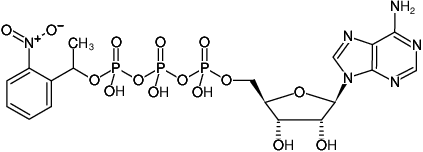Adenosine-5'-triphosphate, P3-(1-(2-nitrophenyl)-ethyl)-ester, Sodium salt
| Cat. No. | Amount | Price (EUR) | Buy / Note |
|---|---|---|---|
| NU-301S | 150 μl (10 mM) | 157,60 | Add to Basket/Quote Add to Notepad |
| NU-301L | 5 x 150 μl (10 mM) | 461,70 | Add to Basket/Quote Add to Notepad |

For general laboratory use.
Shipping: shipped on gel packs
Storage Conditions: store at -20 °C
store dark
Short term exposure (up to 1 week cumulative) to ambient temperature possible.
Shelf Life: 12 months after date of delivery
Molecular Formula: C18H23N6O15P3 (free acid)
Molecular Weight: 656.33 g/mol (free acid)
Exact Mass: 656.04 g/mol (free acid)
CAS#: 67030-27-7
Purity: ≥ 95 % (HPLC)
Form: solution in water
Color: colorless to slightly yellow
Concentration: 10 mM - 11 mM
pH: 7.5 ±0.5
Spectroscopic Properties: λmax 260 nm, ε 18.0 L mmol-1 cm-1 (Tris-HCl pH 7.5)
Applications:
Determination of quantum yield and irradiation conditions[1, 2, 3]
Time resolved solid state NMR[4]
Ligand for purinergic receptors:
The nucleotide can be transported extra- or intracellular in a protected form to the target. After activation by well-defined conditions the liberated ATP can interact with P2X- and P2Y-receptors. Interacting subreceptor types and corresponding references are listed in Data sheet #NU-1010.
Agonistic ligand, mainly for nucleoside receptor A1
Nucleoside-triphosphates can be converted by different membrane-bound phosphatases into nucleosides acting as nucleoside receptor ligands. The caged form is protected during uptake and transport in animal experiments and can be well-directed released through activation at the target tissue.
BIOZ Product Citations:
Selected References:
[1] Omran et al. (2009) Short-length dimethoxynitrophenyl photo-cleavable crosslinkers, synthesis and photolysis. Journal of Photochemistry and Photobiology A: Chemistry 208:125.
[2] Specht et al. (2006) New Photoremovable Protecting Groups for Carboxylic Acids with High Photolytic Efficiencies at Near-UV Irradiation. Application to the Photocontrolled Release of l-Glutamate. ChemBioChem 7:1690.
[3] Zscherp et al. (2001) Reaction-induced infrared difference spectroscopy for the study of protein reaction mechanisms. Biochemistry 40:1875.
[4] Cherepanov et al. (2008) A view on phosphate ester photochemistry by time-resolved solid state NMR. Intramolecular redox reaction of caged ATP. Physical Chemistry Chemical Physics 10:6820.
Volonte et al. (2009) Membrane components and purinergic signalling: the purinome, a complex interplay among ligands, degrading enzymes, receptors and transporters. FEBS J. 276:318.
Yegutkin (2008) Nucleotide and nucleoside converting enzymes: Important modulators of purinergic signalling cascade. Biochim. Biophys. Acta 1783:673.
Scheirlinckx et al. (2001) Monitoring of secondary and tertiary structure changes in the gastric H+/K+-ATPase by infrared spectroscopy Eur. J. Biochem. 268 (13):3644.
Barth et al. (2000) Substrate binding and enzyme function investigated by infrared spectroscopy. FEBS Lett. 477:151.
Hess (1999) Light-Activated (Caged) Biological Ligands. Encyclopedia of Molecular Biology, Vol. 3, T.E. Creighton (Ed.), pp. 1385-1391.
Broustovetsky et al. (1997) Biochemical and physical parameters of the electrical currents measured with the ADP/ATP carrier by photolysis of caged ADP and ATP. Biochemistry 36:13865.
Higuchi et al. (1997) Kinetics of force generation by single kinesin molecules activated by laser photolysis of caged ATP. Proc. Natl. Acad. Sci. USA 94:4395.
Emoto et al. (1995) Tension relaxation induced by pulse photolysis of caged ATP in partially crosslinked fibers from rabbit psoas muscle. Proc. Natl. Acad. Sci. USA 92:1461.
Barth et al. (1995) Photochemical Release of ATP from Caged ATP Studied by Time-Resolved Infrared Spectroscopy. J. Am. Chem. Soc. 117:10311.
Hyman et al. (1992) Microtubule-motor activity of a yeast centromere-binding protein complex. Nature 359:533.
Fajer et al. (1990) Myosin heads have a broad orientational distribution during isometric muscle contraction: time-resolved EPR studies using caged ATP. Proc. Natl. Acad. Sci. USA 87:5538.
Walker et al. (1988) Photolabile 1- (2-Nitrophenyl)ethyl Phosphate Esters of Adenine Nucleotide Analogues. Synthesis and Mechanism of
Photolysis. J. Am. Chem. Soc. 110:7170.
Goldman et al. (1982) Relaxation of muscle-fibers by photolysis of caged ATP. Nature 300:701.